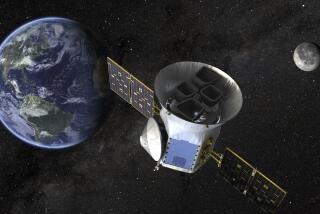NASA finds dozens of planets that might support life
A catalog of possible planets discovered far out in space includes more than 50 candidates that could possibly support life, NASA scientists said Wednesday. If, as expected, most of the planets are confirmed as real, the Kepler mission â now finishing its second year â would nearly triple the number of planets discovered over the last decade and a half.
With 1,235 planetary candidates surrounding a collective 997 stars in an area 500 to 3,000 light-years away, the tally to date provides a wealth of data for scientists to sift through in search of Earth-like planets.
âThis is the first step in understanding the possible distribution of life in our galaxy,â said William Borucki, principal investigator for the Kepler mission at NASA Ames Research Center in the Bay Areaâs Moffett Field.
He noted that of the candidate planets, 54 reside in the so-called Goldilocks range â in a âjust rightâ distance from its star to be neither too hot nor too cold to permit liquid water and therefore the presence of life as we know it. Five of those 54 are close to Earthâs size.
The space-based Kepler telescope, which circles the sun trailing Earthâs orbit, observes more than 155,000 stars and every half-hour measures the amount of light they give off. If a planet is orbiting a star, it is detectable because it temporarily blocks a bit of light each time it crosses in front of its star.
By measuring how much of a starâs light a planet blocks during such transits, scientists can deduce what the planetâs radius must be. By tracking how frequently each planet transits, they can determine how closely it orbits its star.
And in the case of very massive planets, researchers can estimate a planetâs mass based on how much a star âwobblesâ in response to the planetâs gravitational pull.
Prior to Kepler, scientists had confirmed the existence of more than 500 planets outside our solar system, which are known as exoplanets. Among the 1,235 new candidates, 68 are Earth-sized, 288 are super-Earth-sized (up to about 10 times the Earthâs mass), 662 are Neptune-sized and 165 are about the size of Jupiter, the largest planet within our solar system, Borucki said. Nineteen are up to twice the size of Jupiter.
UC Santa Cruz planetary scientist Jonathan Fortney, one of dozens of scientists on the Kepler team, helped identify a particularly rare find â six planets orbiting around an 8-billion-year-old star named Kepler-11, which is about 2,000 light-years away and much like our sun in size.
The findings were reported Wednesday in the journal Nature.
Unusually, five of the six planets were closer to Kepler-11 than Mercury is to the sun. Even stranger, the six planets orbit the star on the same plane, Fortney said; the star system, he said, is âflatter than a CD.â
This flatness allowed all six planets to be seen crossing Kepler-11. It also helped the scientists to measure how the planetsâ gravitational tugs affected each otherâs orbits, and thus to determine the mass of each one. There may be many more planets in this system that have not been detected, scientists said.
Because having multiple planets in one system provides a richer detail on a solar system, the Kepler-11 system âtells us something very fundamental about planet formation, about the kind of galaxy we live in, the kind of planets around us,â Fortney said.
The Kepler mission is scheduled to continue for another year and a half, and is expected to cost about $600 million.
Daniel Apai, an astronomer at the Space Telescope Science Institute in Baltimore, called the Kepler-11 systemâs known structure and dynamics âamazing.â
âKepler is in many ways pushing us to rethink planet formation,â Apai said.






